MAZDA MODEL CX-5 2013 Owners Manual (in English)
Manufacturer: MAZDA, Model Year: 2013, Model line: MODEL CX-5, Model: MAZDA MODEL CX-5 2013Pages: 488, PDF Size: 8.75 MB
Page 181 of 488

Black plate (181,1)
Brake System
qFoot Brake
Your Mazda has power-assisted brakes
that adjust automatically through normal
use.
Should power-assist fail, you can stop by
applying greater force than normal to the
brake pedal. But the distance required to
stop will be greater than usual.
WARNING
Do not coast with the engine stalled or
turned off, find a safe place to stop:
Coasting with the engine stalled or
turned off is dangerous. Braking will
require more effort, and the brake's
power-assist could be depleted if you
pump the brake. This will cause
longer stopping distances or even an
accident.
Shift to a lower gear when going down
steep hills:
Driving with your foot continuously
on the brake pedal or steadily
applying the brakes for long
distances is dangerous. This causes
overheated brakes, resulting in
longer stopping distances or even
total brake failure. This could cause
loss of vehicle control and a serious
accident. Avoid continuous
application of the brakes.
Dry off brakes that have become wet
by driving slowly, releasing the
accelerator pedal and lightly applying
the brakes several times until the brake
performance returns to normal:
Driving with wet brakes is
dangerous. Increased stopping
distance or the vehicle pulling to one
side when braking could result in a
serious accident. Light braking will
indicate whether the brakes have
been affected.
When Driving
Brake
4-57
CX-5_8CA5-EA-11L_Edition3 Page181
Friday, June 22 2012 3:45 PM
Form No.8CA5-EA-11L
Page 182 of 488
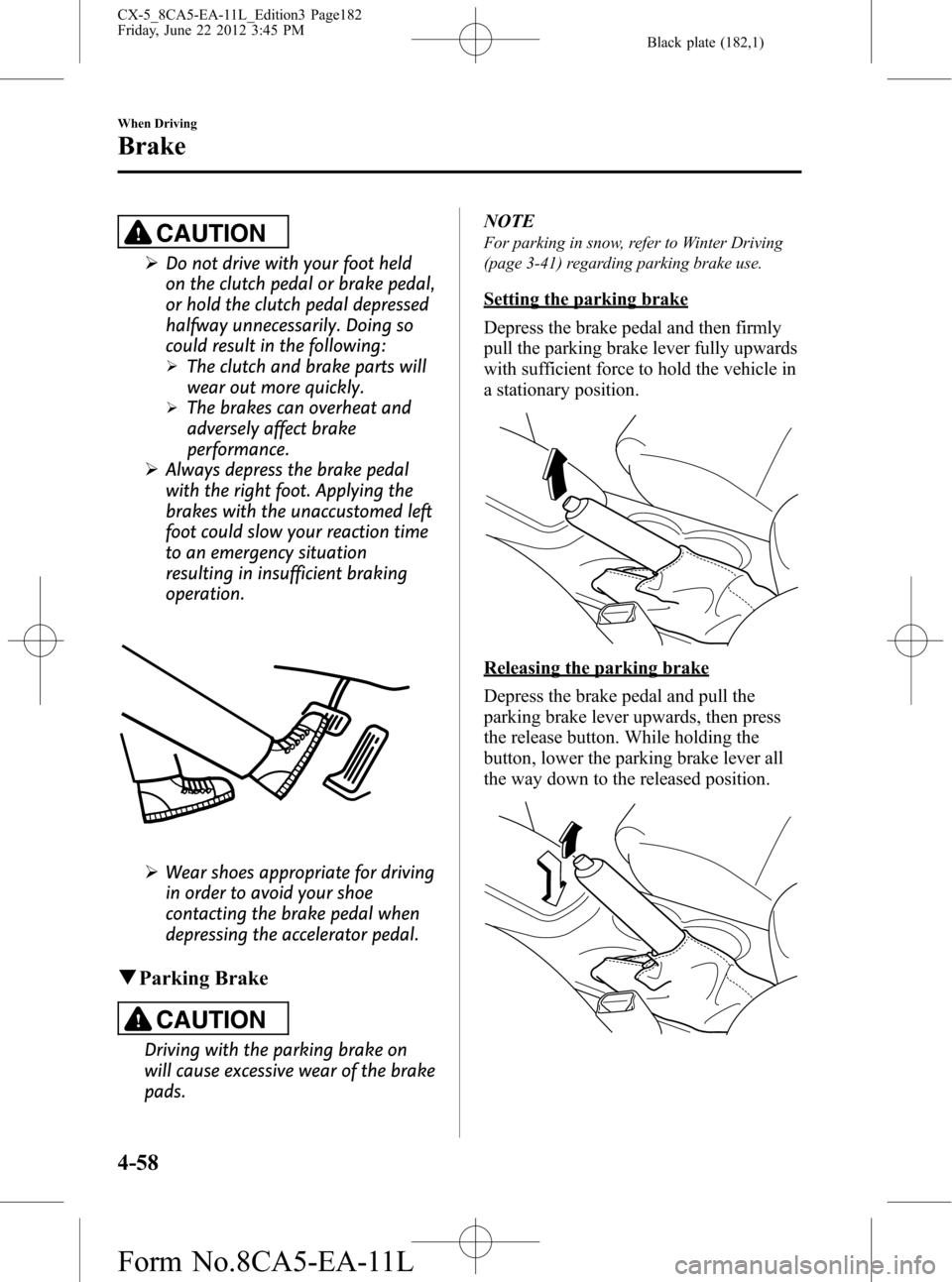
Black plate (182,1)
CAUTION
ØDo not drive with your foot held
on the clutch pedal or brake pedal,
or hold the clutch pedal depressed
halfway unnecessarily. Doing so
could result in the following:
ØThe clutch and brake parts will
wear out more quickly.
ØThe brakes can overheat and
adversely affect brake
performance.
ØAlways depress the brake pedal
with the right foot. Applying the
brakes with the unaccustomed left
foot could slow your reaction time
to an emergency situation
resulting in insufficient braking
operation.
ØWear shoes appropriate for driving
in order to avoid your shoe
contacting the brake pedal when
depressing the accelerator pedal.
qParking Brake
CAUTION
Driving with the parking brake on
will cause excessive wear of the brake
pads.NOTE
For parking in snow, refer to Winter Driving
(page 3-41) regarding parking brake use.
Setting the parking brake
Depress the brake pedal and then firmly
pull the parking brake lever fully upwards
with sufficient force to hold the vehicle in
a stationary position.
Releasing the parking brake
Depress the brake pedal and pull the
parking brake lever upwards, then press
the release button. While holding the
button, lower the parking brake lever all
the way down to the released position.
4-58
When Driving
Brake
CX-5_8CA5-EA-11L_Edition3 Page182
Friday, June 22 2012 3:45 PM
Form No.8CA5-EA-11L
Page 183 of 488
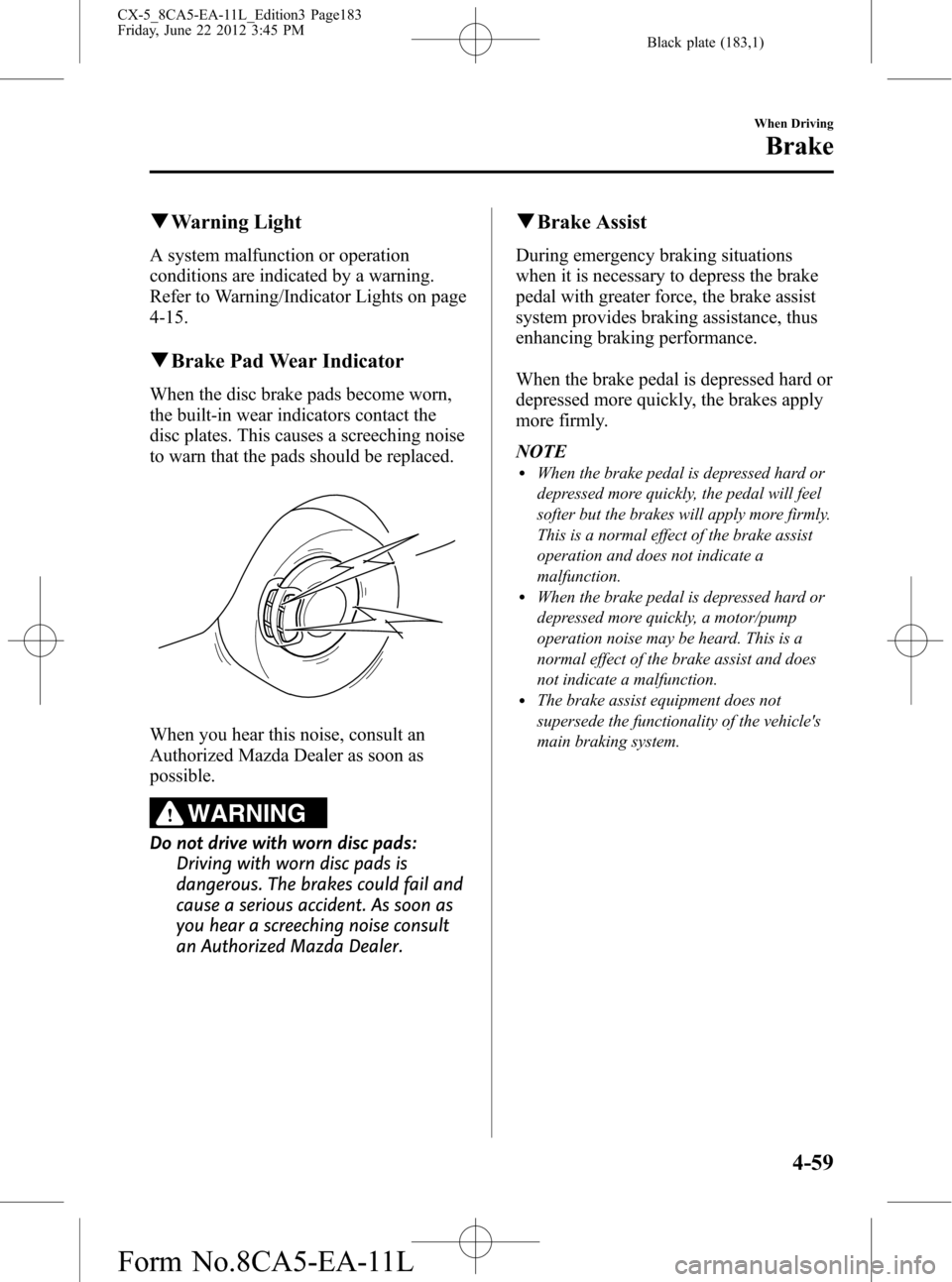
Black plate (183,1)
qWarning Light
A system malfunction or operation
conditions are indicated by a warning.
Refer to Warning/Indicator Lights on page
4-15.
qBrake Pad Wear Indicator
When the disc brake pads become worn,
the built-in wear indicators contact the
disc plates. This causes a screeching noise
to warn that the pads should be replaced.
When you hear this noise, consult an
Authorized Mazda Dealer as soon as
possible.
WARNING
Do not drive with worn disc pads:
Driving with worn disc pads is
dangerous. The brakes could fail and
cause a serious accident. As soon as
you hear a screeching noise consult
an Authorized Mazda Dealer.
qBrake Assist
During emergency braking situations
when it is necessary to depress the brake
pedal with greater force, the brake assist
system provides braking assistance, thus
enhancing braking performance.
When the brake pedal is depressed hard or
depressed more quickly, the brakes apply
more firmly.
NOTE
lWhen the brake pedal is depressed hard or
depressed more quickly, the pedal will feel
softer but the brakes will apply more firmly.
This is a normal effect of the brake assist
operation and does not indicate a
malfunction.
lWhen the brake pedal is depressed hard or
depressed more quickly, a motor/pump
operation noise may be heard. This is a
normal effect of the brake assist and does
not indicate a malfunction.
lThe brake assist equipment does not
supersede the functionality of the vehicle's
main braking system.
When Driving
Brake
4-59
CX-5_8CA5-EA-11L_Edition3 Page183
Friday, June 22 2012 3:45 PM
Form No.8CA5-EA-11L
Page 184 of 488
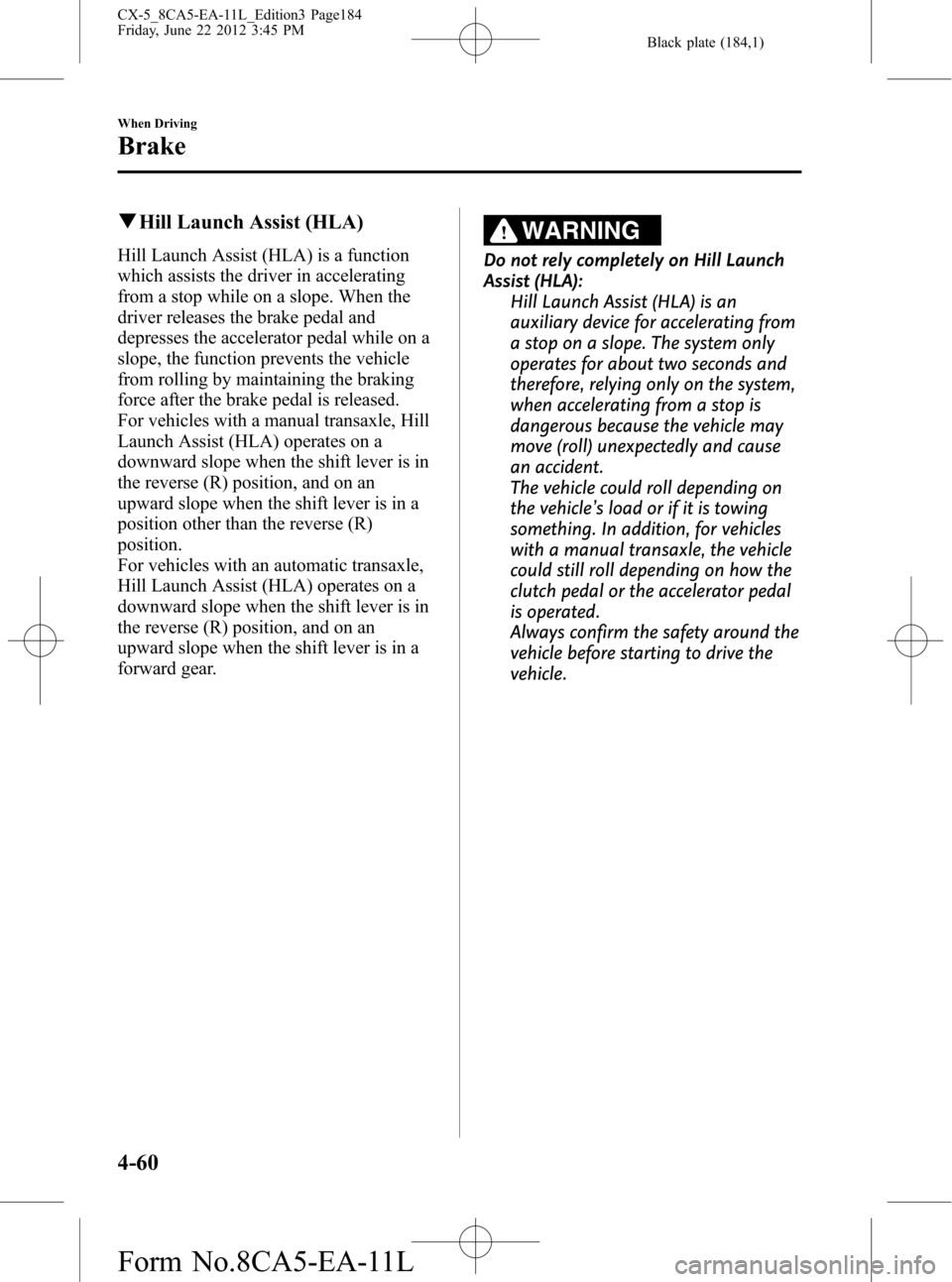
Black plate (184,1)
qHill Launch Assist (HLA)
Hill Launch Assist (HLA) is a function
which assists the driver in accelerating
from a stop while on a slope. When the
driver releases the brake pedal and
depresses the accelerator pedal while on a
slope, the function prevents the vehicle
from rolling by maintaining the braking
force after the brake pedal is released.
For vehicles with a manual transaxle, Hill
Launch Assist (HLA) operates on a
downward slope when the shift lever is in
the reverse (R) position, and on an
upward slope when the shift lever is in a
position other than the reverse (R)
position.
For vehicles with an automatic transaxle,
Hill Launch Assist (HLA) operates on a
downward slope when the shift lever is in
the reverse (R) position, and on an
upward slope when the shift lever is in a
forward gear.
WARNING
Do not rely completely on Hill Launch
Assist (HLA):
Hill Launch Assist (HLA) is an
auxiliary device for accelerating from
a stop on a slope. The system only
operates for about two seconds and
therefore, relying only on the system,
when accelerating from a stop is
dangerous because the vehicle may
move (roll) unexpectedly and cause
an accident.
The vehicle could roll depending on
the vehicle’s load or if it is towing
something. In addition, for vehicles
with a manual transaxle, the vehicle
could still roll depending on how the
clutch pedal or the accelerator pedal
is operated.
Always confirm the safety around the
vehicle before starting to drive the
vehicle.
4-60
When Driving
Brake
CX-5_8CA5-EA-11L_Edition3 Page184
Friday, June 22 2012 3:45 PM
Form No.8CA5-EA-11L
Page 185 of 488
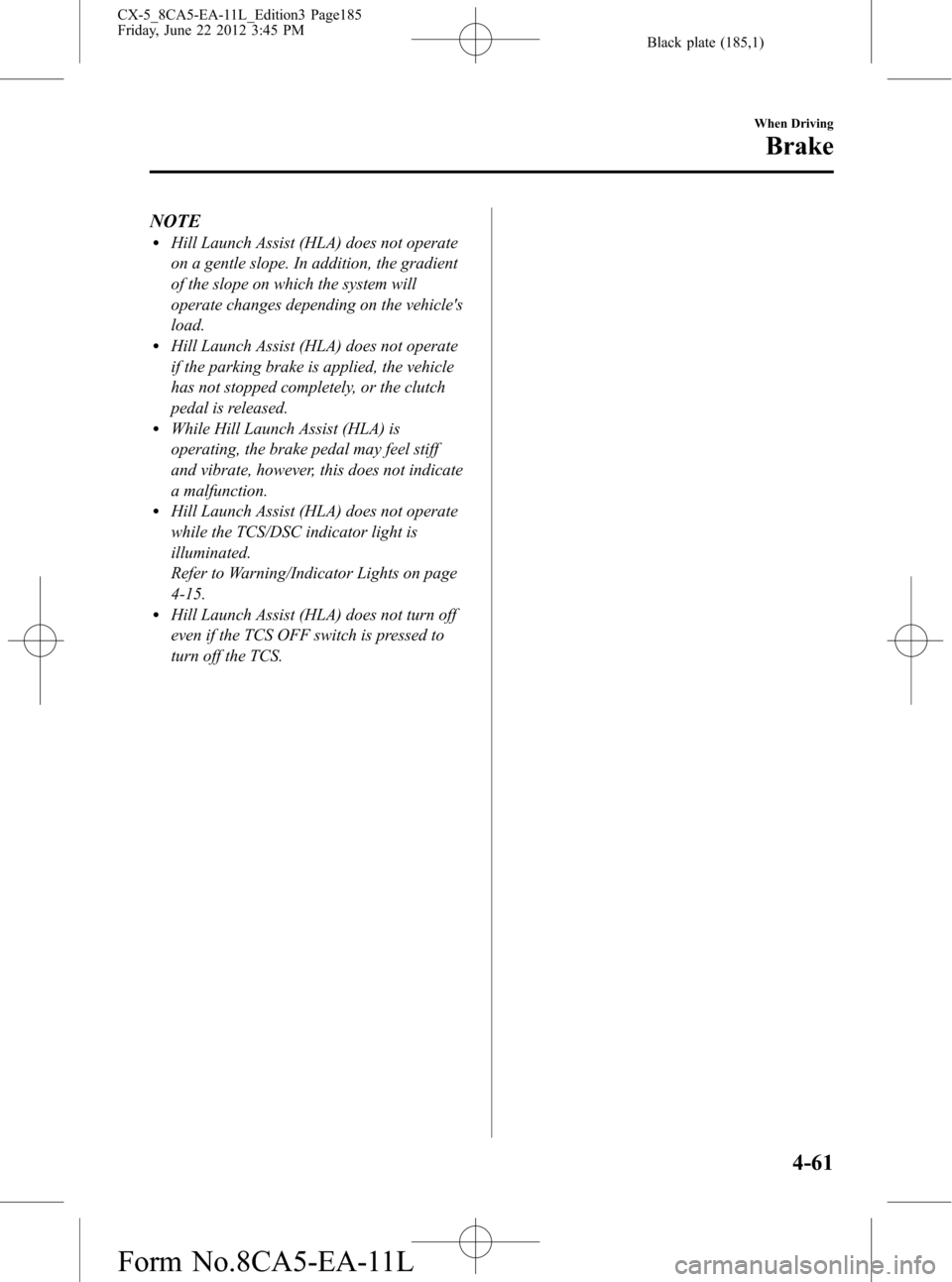
Black plate (185,1)
NOTElHill Launch Assist (HLA) does not operate
on a gentle slope. In addition, the gradient
of the slope on which the system will
operate changes depending on the vehicle's
load.
lHill Launch Assist (HLA) does not operate
if the parking brake is applied, the vehicle
has not stopped completely, or the clutch
pedal is released.
lWhile Hill Launch Assist (HLA) is
operating, the brake pedal may feel stiff
and vibrate, however, this does not indicate
a malfunction.
lHill Launch Assist (HLA) does not operate
while the TCS/DSC indicator light is
illuminated.
Refer to Warning/Indicator Lights on page
4-15.
lHill Launch Assist (HLA) does not turn off
even if the TCS OFF switch is pressed to
turn off the TCS.
When Driving
Brake
4-61
CX-5_8CA5-EA-11L_Edition3 Page185
Friday, June 22 2012 3:45 PM
Form No.8CA5-EA-11L
Page 186 of 488
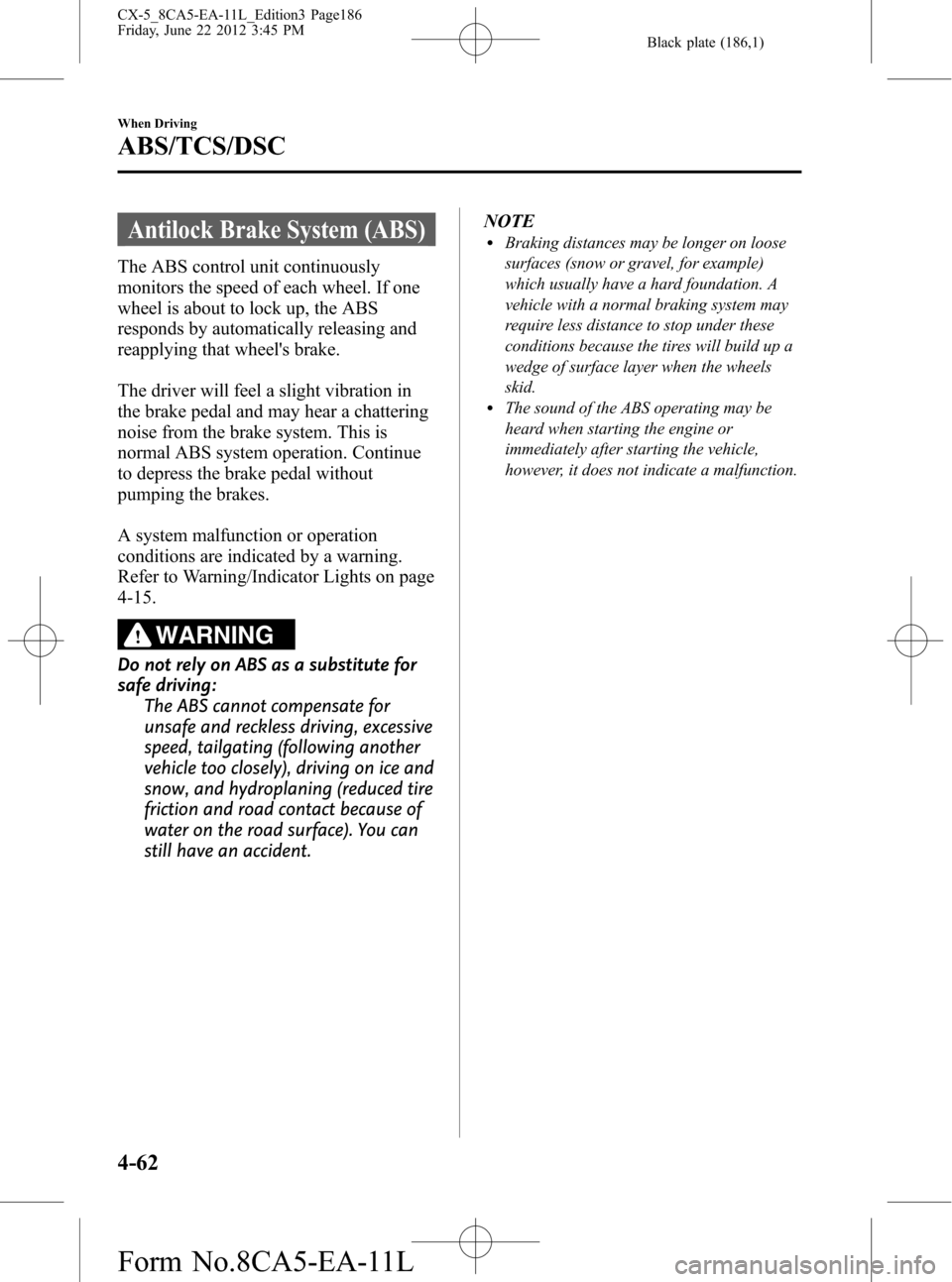
Black plate (186,1)
Antilock Brake System (ABS)
The ABS control unit continuously
monitors the speed of each wheel. If one
wheel is about to lock up, the ABS
responds by automatically releasing and
reapplying that wheel's brake.
The driver will feel a slight vibration in
the brake pedal and may hear a chattering
noise from the brake system. This is
normal ABS system operation. Continue
to depress the brake pedal without
pumping the brakes.
A system malfunction or operation
conditions are indicated by a warning.
Refer to Warning/Indicator Lights on page
4-15.
WARNING
Do not rely on ABS as a substitute for
safe driving:
The ABS cannot compensate for
unsafe and reckless driving, excessive
speed, tailgating (following another
vehicle too closely), driving on ice and
snow, and hydroplaning (reduced tire
friction and road contact because of
water on the road surface). You can
still have an accident.NOTE
lBraking distances may be longer on loose
surfaces (snow or gravel, for example)
which usually have a hard foundation. A
vehicle with a normal braking system may
require less distance to stop under these
conditions because the tires will build up a
wedge of surface layer when the wheels
skid.
lThe sound of the ABS operating may be
heard when starting the engine or
immediately after starting the vehicle,
however, it does not indicate a malfunction.
4-62
When Driving
ABS/TCS/DSC
CX-5_8CA5-EA-11L_Edition3 Page186
Friday, June 22 2012 3:45 PM
Form No.8CA5-EA-11L
Page 187 of 488
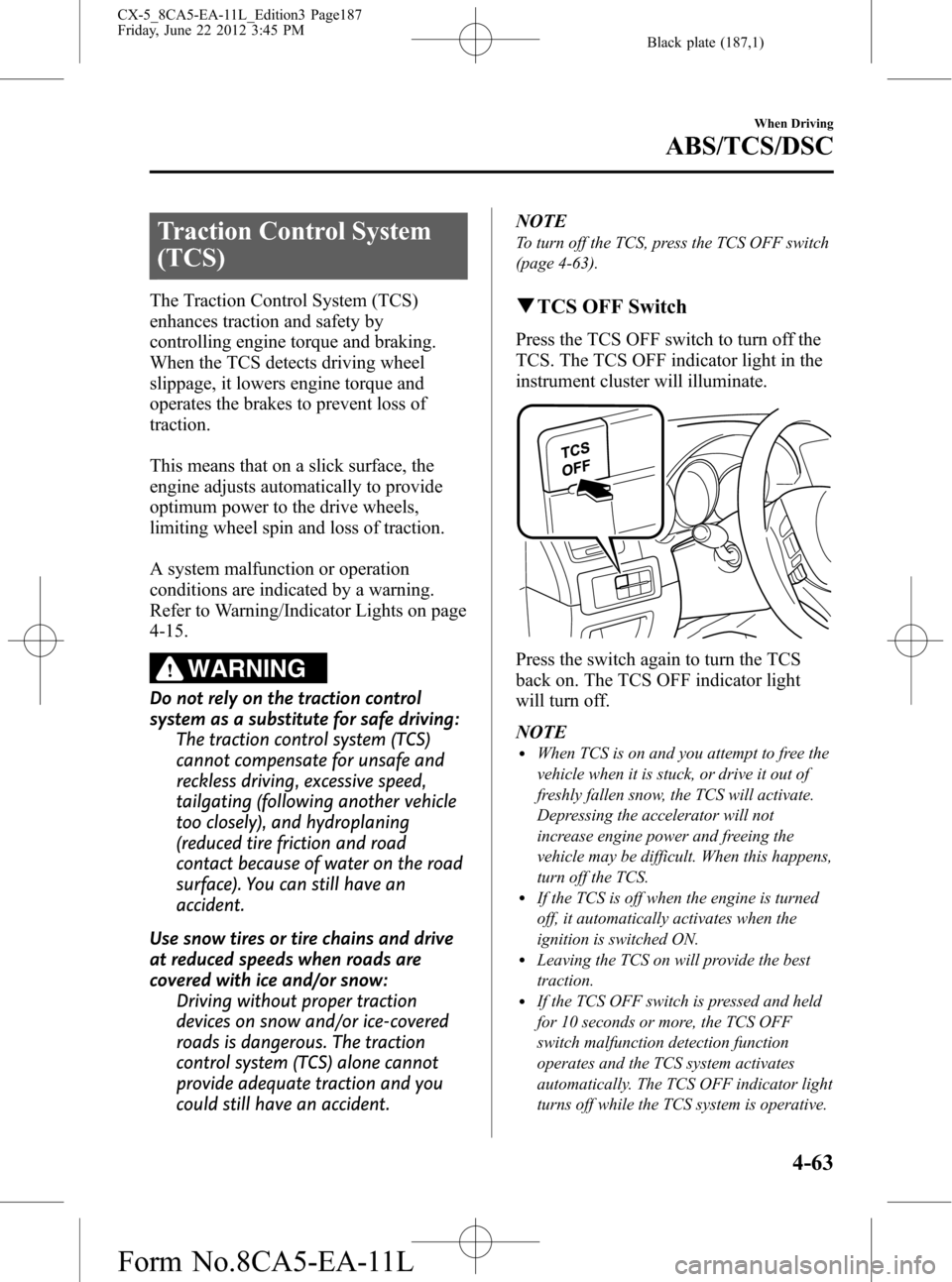
Black plate (187,1)
Traction Control System
(TCS)
The Traction Control System (TCS)
enhances traction and safety by
controlling engine torque and braking.
When the TCS detects driving wheel
slippage, it lowers engine torque and
operates the brakes to prevent loss of
traction.
This means that on a slick surface, the
engine adjusts automatically to provide
optimum power to the drive wheels,
limiting wheel spin and loss of traction.
A system malfunction or operation
conditions are indicated by a warning.
Refer to Warning/Indicator Lights on page
4-15.
WARNING
Do not rely on the traction control
system as a substitute for safe driving:
The traction control system (TCS)
cannot compensate for unsafe and
reckless driving, excessive speed,
tailgating (following another vehicle
too closely), and hydroplaning
(reduced tire friction and road
contact because of water on the road
surface). You can still have an
accident.
Use snow tires or tire chains and drive
at reduced speeds when roads are
covered with ice and/or snow:
Driving without proper traction
devices on snow and/or ice-covered
roads is dangerous. The traction
control system (TCS) alone cannot
provide adequate traction and you
could still have an accident.NOTE
To turn off the TCS, press the TCS OFF switch
(page 4-63).
qTCS OFF Switch
Press the TCS OFF switch to turn off the
TCS. The TCS OFF indicator light in the
instrument cluster will illuminate.
Press the switch again to turn the TCS
back on. The TCS OFF indicator light
will turn off.
NOTE
lWhen TCS is on and you attempt to free the
vehicle when it is stuck, or drive it out of
freshly fallen snow, the TCS will activate.
Depressing the accelerator will not
increase engine power and freeing the
vehicle may be difficult. When this happens,
turn off the TCS.
lIf the TCS is off when the engine is turned
off, it automatically activates when the
ignition is switched ON.
lLeaving the TCS on will provide the best
traction.
lIf the TCS OFF switch is pressed and held
for 10 seconds or more, the TCS OFF
switch malfunction detection function
operates and the TCS system activates
automatically. The TCS OFF indicator light
turns off while the TCS system is operative.
When Driving
ABS/TCS/DSC
4-63
CX-5_8CA5-EA-11L_Edition3 Page187
Friday, June 22 2012 3:45 PM
Form No.8CA5-EA-11L
Page 188 of 488
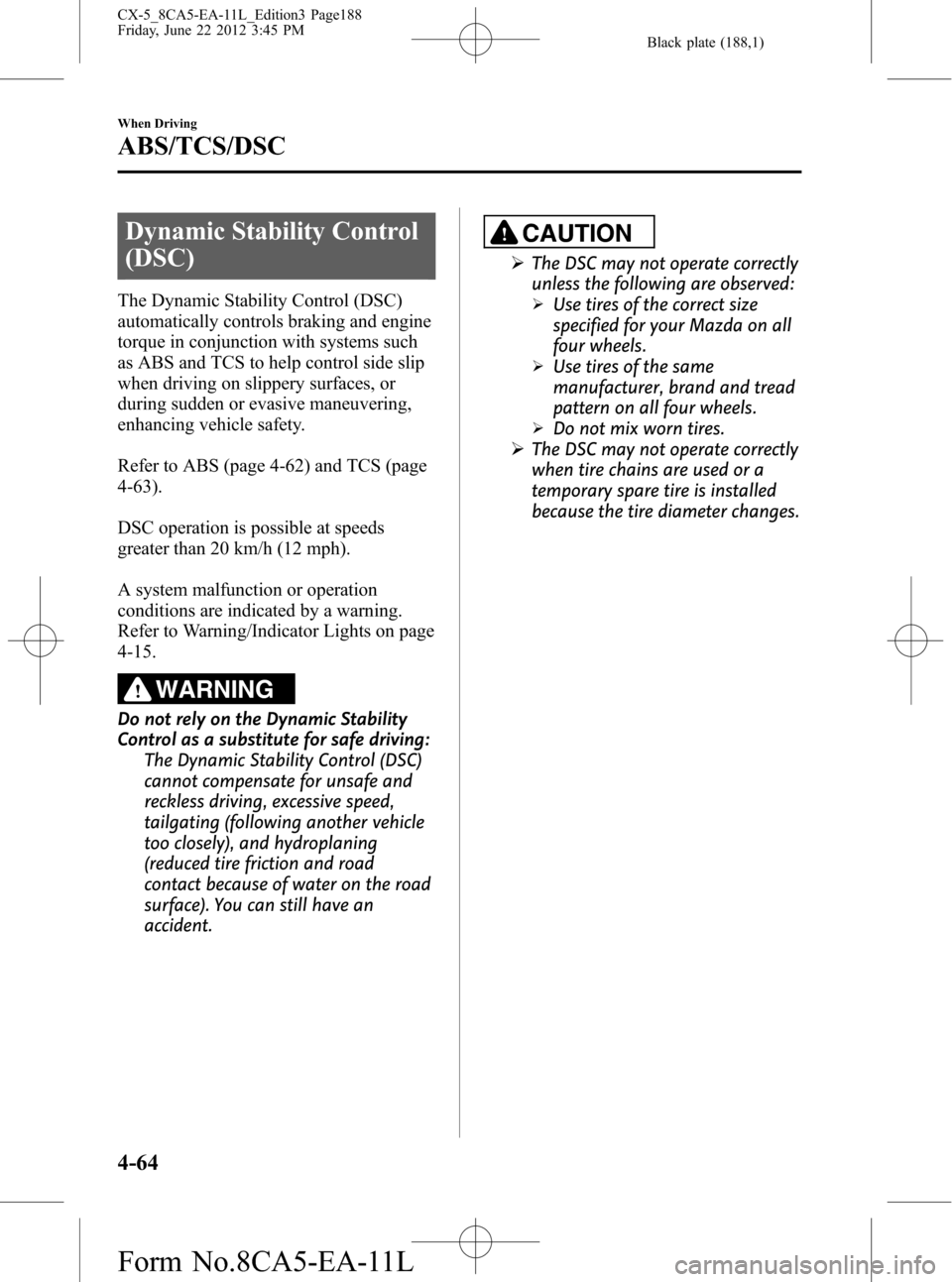
Black plate (188,1)
Dynamic Stability Control
(DSC)
The Dynamic Stability Control (DSC)
automatically controls braking and engine
torque in conjunction with systems such
as ABS and TCS to help control side slip
when driving on slippery surfaces, or
during sudden or evasive maneuvering,
enhancing vehicle safety.
Refer to ABS (page 4-62) and TCS (page
4-63).
DSC operation is possible at speeds
greater than 20 km/h (12 mph).
A system malfunction or operation
conditions are indicated by a warning.
Refer to Warning/Indicator Lights on page
4-15.
WARNING
Do not rely on the Dynamic Stability
Control as a substitute for safe driving:
The Dynamic Stability Control (DSC)
cannot compensate for unsafe and
reckless driving, excessive speed,
tailgating (following another vehicle
too closely), and hydroplaning
(reduced tire friction and road
contact because of water on the road
surface). You can still have an
accident.
CAUTION
ØThe DSC may not operate correctly
unless the following are observed:
ØUse tires of the correct size
specified for your Mazda on all
four wheels.
ØUse tires of the same
manufacturer, brand and tread
pattern on all four wheels.
ØDo not mix worn tires.
ØThe DSC may not operate correctly
when tire chains are used or a
temporary spare tire is installed
because the tire diameter changes.
4-64
When Driving
ABS/TCS/DSC
CX-5_8CA5-EA-11L_Edition3 Page188
Friday, June 22 2012 3:45 PM
Form No.8CA5-EA-11L
Page 189 of 488
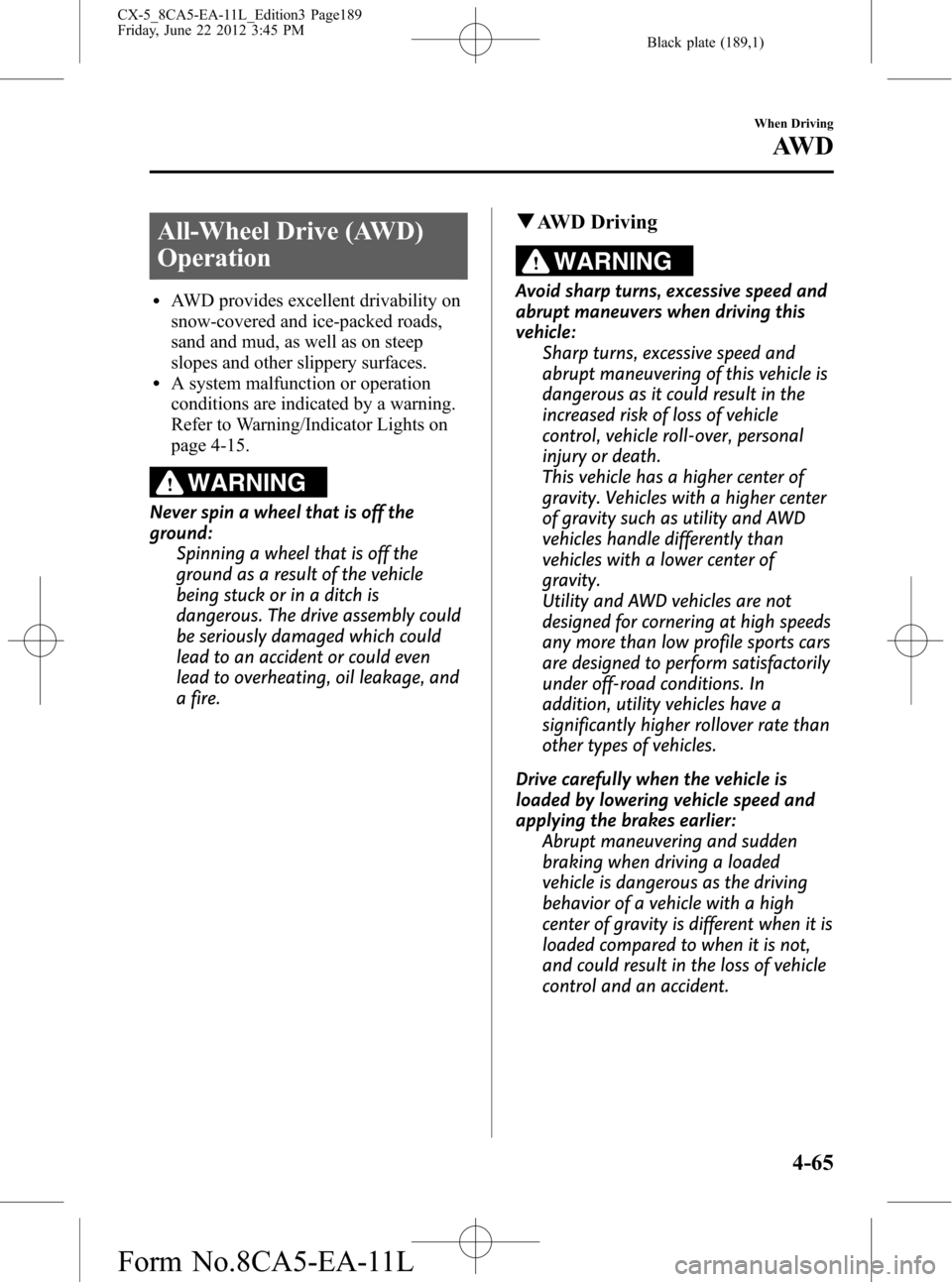
Black plate (189,1)
All-Wheel Drive (AWD)
Operation
lAWD provides excellent drivability on
snow-covered and ice-packed roads,
sand and mud, as well as on steep
slopes and other slippery surfaces.
lA system malfunction or operation
conditions are indicated by a warning.
Refer to Warning/Indicator Lights on
page 4-15.
WARNING
Never spin a wheel that is off the
ground:
Spinning a wheel that is off the
ground as a result of the vehicle
being stuck or in a ditch is
dangerous. The drive assembly could
be seriously damaged which could
lead to an accident or could even
lead to overheating, oil leakage, and
a fire.
qAWD Driving
WARNING
Avoid sharp turns, excessive speed and
abrupt maneuvers when driving this
vehicle:
Sharp turns, excessive speed and
abrupt maneuvering of this vehicle is
dangerous as it could result in the
increased risk of loss of vehicle
control, vehicle roll-over, personal
injury or death.
This vehicle has a higher center of
gravity. Vehicles with a higher center
of gravity such as utility and AWD
vehicles handle differently than
vehicles with a lower center of
gravity.
Utility and AWD vehicles are not
designed for cornering at high speeds
any more than low profile sports cars
are designed to perform satisfactorily
under off-road conditions. In
addition, utility vehicles have a
significantly higher rollover rate than
other types of vehicles.
Drive carefully when the vehicle is
loaded by lowering vehicle speed and
applying the brakes earlier:
Abrupt maneuvering and sudden
braking when driving a loaded
vehicle is dangerous as the driving
behavior of a vehicle with a high
center of gravity is different when it is
loaded compared to when it is not,
and could result in the loss of vehicle
control and an accident.
When Driving
AW D
4-65
CX-5_8CA5-EA-11L_Edition3 Page189
Friday, June 22 2012 3:45 PM
Form No.8CA5-EA-11L
Page 190 of 488
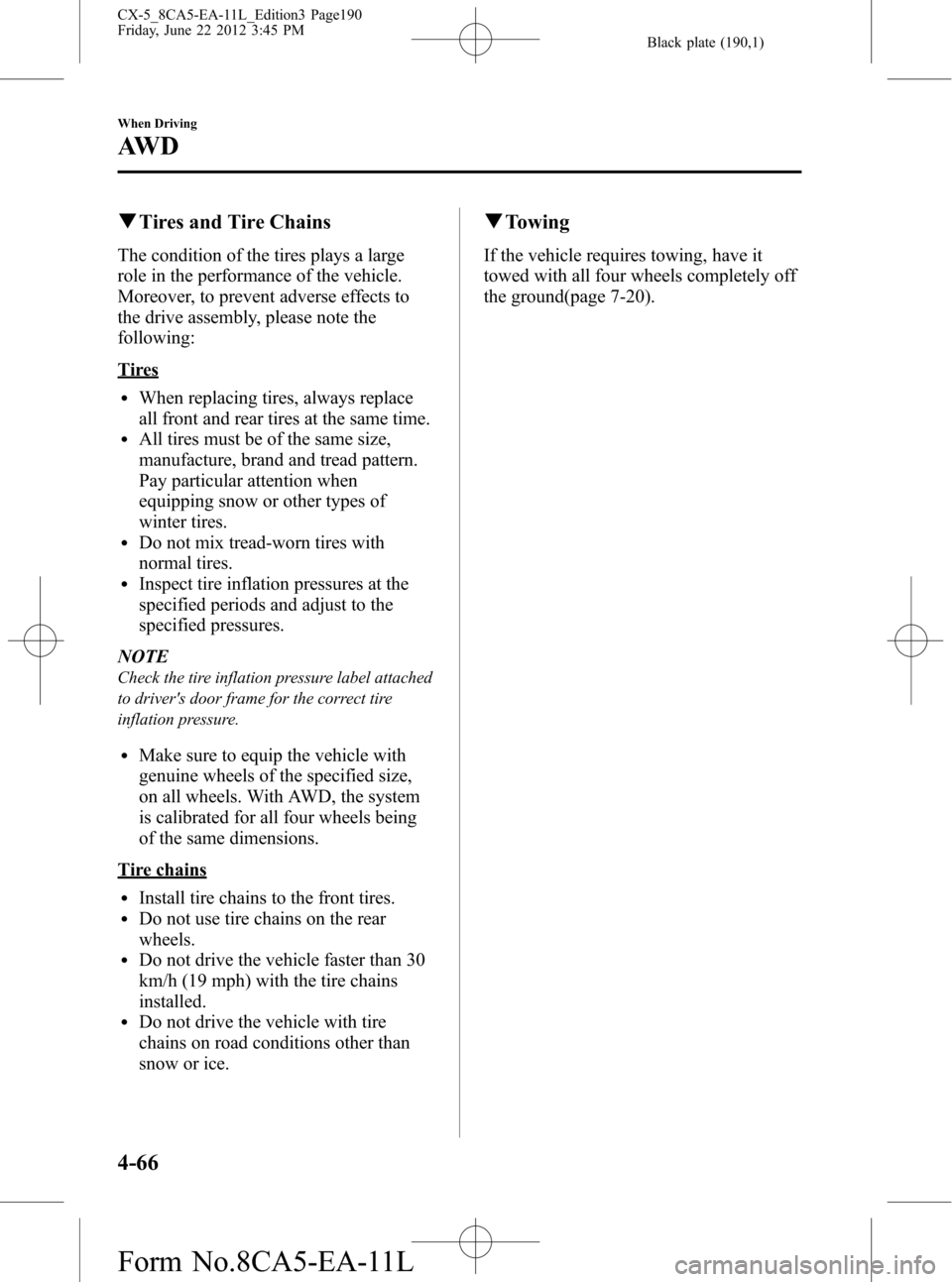
Black plate (190,1)
qTires and Tire Chains
The condition of the tires plays a large
role in the performance of the vehicle.
Moreover, to prevent adverse effects to
the drive assembly, please note the
following:
Tires
lWhen replacing tires, always replace
all front and rear tires at the same time.
lAll tires must be of the same size,
manufacture, brand and tread pattern.
Pay particular attention when
equipping snow or other types of
winter tires.
lDo not mix tread-worn tires with
normal tires.
lInspect tire inflation pressures at the
specified periods and adjust to the
specified pressures.
NOTE
Check the tire inflation pressure label attached
to driver's door frame for the correct tire
inflation pressure.
lMake sure to equip the vehicle with
genuine wheels of the specified size,
on all wheels. With AWD, the system
is calibrated for all four wheels being
of the same dimensions.
Tire chains
lInstall tire chains to the front tires.lDo not use tire chains on the rear
wheels.
lDo not drive the vehicle faster than 30
km/h (19 mph) with the tire chains
installed.
lDo not drive the vehicle with tire
chains on road conditions other than
snow or ice.
qTowing
If the vehicle requires towing, have it
towed with all four wheels completely off
the ground(page 7-20).
4-66
When Driving
AW D
CX-5_8CA5-EA-11L_Edition3 Page190
Friday, June 22 2012 3:45 PM
Form No.8CA5-EA-11L